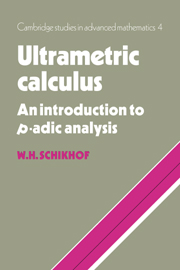Summary
This elementary book is intended for advanced undergraduates or anyone on a higher level who wants to learn the basic facts of p-adic analysis. We only assume the reader to have some standard knowledge of analysis and algebra.
In analysis (and outside it) the fields ℝ and ℂ play a central role. For several reasons people started to study the implications of replacing ℝ or ℂ by a more general object, viz. a field K with a complete valuation │ │ comparable to the absolute value function (see Definition 1.1). Many such fields other than ℝ or ℂ exist, their valuations are all ‘non-archimedean’, i.e. they satisfy the ‘strong triangle inequality’ │x + y│ ≤ max(│x│, │y│). The analysis in and over non-archimedean valued fields K is known as ultrametric (non-archimedean, p-adic) analysis.
In this book we shall treat the basic facts of ultrametric analysis together to form an alternative ‘one variable calculus course’. Thus, in K we shall consider familiar concepts such as continuity, differentiability, (power) series, integration, etc. However, the strong triangle inequality causes fascinating deviations from the ‘classical analysis’ (over ℝ or ℂ); let us mention a few of them.
(i) A series Σan in K converges if limn → ∞an = 0. The power series Σxn/n! of exp (if it makes sense at all) converges only on a disc strictly contained in the closed unit disc {x : │x│ ≤ 1}. Hence Σ1/n! diverges (but Σn! converges in many K).
- Type
- Chapter
- Information
- Ultrametric CalculusAn Introduction to p-Adic Analysis, pp. ix - xiiPublisher: Cambridge University PressPrint publication year: 1985



